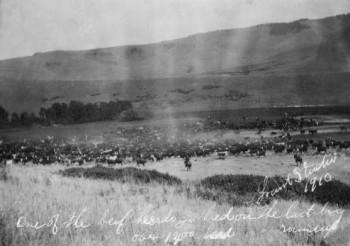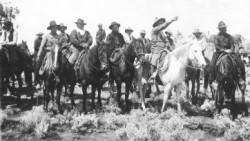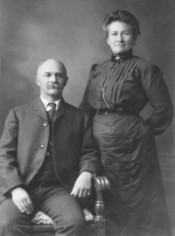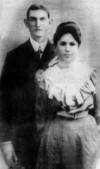Irvine Flats
Irvine Flats was named after William "Billy"

Billy Irvine Last Big Cattle Roundup in 1910
prior to Homesteaders [Swope Collection]
Irvine. According to MONTANA ITS STORY AND BIOGRAPHY Billy Irvine was "one of the acknowledged ranchers on good livestock, and every condition regarding the breeding, raising, care and marketing of stock in Montana." Billy Irvine was born to Mr. and Mrs. Peter Irvine six miles north of the St. Ignatius Mission at Post Creek, on June 15, 1856. His Scottish father Peter worked at Fort Connah. Peter and his Flathead wife had nine children with Billy being oldest. The family were personal friends of Father Anthony Ravalli. Billy "grew up on a horse in the saddle," worked as a cowboy, and traveled as top hand with famous outfits throughout the West. By 1886 Billy returned to the Flathead. He was staked to his first small herd, about 300 head, by Charles Allard, Sr. and located himself on 5000 acres on the west side of the river, about seventeen miles west of Polson. He wintered his numerous cattle there and in the spring drove them to pasture along the Pend d’Oreille River, later called the Flathead River. William Irvine married

Billy Irvine on white horse, Art
Larrivee wit white neck scarf
[Swope collection]
Mrs. Emily Brown Larrivee in 1896. Mrs. Irvine’s son Arthur Larrivee, who Billy raised, would later badly manage the ranch requiring the retired Billy to return and restore it to working condition. William Irvine died at

William and Emily Irvine
[Swope/Heligie Collection]
Polson on June 17, 1939. Francis "Tat" Browne, a relative later managed and owned the ranch until the Swopes purchased 3200 acres of the original property.Homesteaders came to Irvine Flats in 1910 when the government opened that land for 160 acre homesteads. While the Irvine Flats area now seems barren, old-timers like Paul Smith said, "There were houses out here you wouldn’t believe." Settlers soon needed schools, so in 1911 Flathead County split the rapidlydeveloping Irvine Flats into one, two

Walter and
Lena Kramer,
1904 [Ruth
Gruinard
Collection]
and then three school districts as the homesteaders continued to come onto each 160 acres. Four schools were eventually built — the Log School, the Green Mountain School, the White School, and the Brown school. Scattered remains of desks of the old Log School still sit on Section 30 of the old Irvine place.
